Cagelike Octacopper Methylsilsesquioxanes: Self-Assembly in the Focus of Alkaline Metal Ion Influence—Synthesis, Structure, and Catalytic Activity
Abstract
:1. Introduction
2. Results
2.1. Synthesis and Structure
2.2. Catalytic Studies
2.3. Oxidation of Alcohols
3. General Experimental Considerations
3.1. Syntheses of 1–4
3.2. X-ray Crystal Structure Determination
3.3. Structural Features of Complex 1a
3.4. Catalytic Studies
4. Conclusions
Author Contributions
Funding
Institutional Review Board Statement
Informed Consent Statement
Data Availability Statement
Conflicts of Interest
Sample Availability
References
- Murugavel, R.; Voigt, A.; Walawalkar, M.G.; Roesky, H.W. Hetero- and Metallasiloxanes Derived from Silanediols, Disilanols, Silanetriols, and Trisilanols. Chem. Rev. 1996, 96, 2205–2223. [Google Scholar] [CrossRef] [PubMed]
- Lorenz, V.; Fischer, A.; Gießmann, S.; Gilje, J.W.; Gun’ko, Y.; Jacob, K.; Edelmann, F.T. Disiloxanediolates and polyhedral metallasilsesquioxanes of the early transition metals and f-elements. Coord. Chem. Rev. 2000, 206–207, 321–368. [Google Scholar] [CrossRef]
- Hanssen, R.W.J.M.; van Santen, R.A.; Abbenhuis, H.C.L. The Dynamic Status Quo of Polyhedral Silsesquioxane Coordination Chemistry. Eur. J. Inorg. Chem. 2004, 2004, 675–683. [Google Scholar] [CrossRef]
- Roesky, H.W.; Anantharaman, G.; Chandrasekhar, V.; Jancik, V.; Singh, S. Control of Molecular Topology and Metal Nuclearity in Multimetallic Assemblies: Designer Metallosiloxanes Derived from Silanetriols. Chem. Eur. J. 2004, 10, 4106–4114. [Google Scholar] [CrossRef]
- Lorenz, V.; Edelmann, F.T. Metallasilsesquioxanes. Adv. Organomet. Chem. 2005, 53, 101–153. [Google Scholar]
- Levitsky, M.M.; Zavin, B.G.; Bilyachenko, A. Chemistry of metallasiloxanes. Current trends and new concepts. Russ. Chem. Rev. 2007, 76, 847–866. [Google Scholar] [CrossRef]
- Edelmann, F.T. Metallasilsesquioxanes–Synthetic and Structural Studies. In Silicon Chemistry: From the Atom to Extended Systems; Jutzi, P., Schubert, U., Eds.; Wiley: Darmstadt, Germany, 2003; pp. 383–394. [Google Scholar]
- Levitsky, M.M.; Bilyachenko, A.N. Modern concepts and methods in the chemistry of polyhedral metallasiloxanes. Coord. Chem. Rev. 2016, 306, 235–269. [Google Scholar] [CrossRef]
- Zheng, Y.; Gao, Z.; Han, J. Current Chemistry of Cyclic Oligomeric Silsesquioxanes. Curr. Org. Chem. 2018, 21, 2814–2828. [Google Scholar] [CrossRef]
- Ouyang, J.; Haotian, S.; Liang, Y.; Commisso, A.; Li, D.; Xu, R.; Yu, D. Recent Progress in Metal-containing Silsesquioxanes: Preparation and Application. Curr. Org. Chem. 2018, 21, 2829–2848. [Google Scholar] [CrossRef]
- Levitsky, M.M.; Zubavichus, Y.V.; Korlyukov, A.A.; Khrustalev, V.N.; Shubina, E.S.; Bilyachenko, A.N. Silicon and Germanium-Based Sesquioxanes as Versatile Building Blocks for Cage Metallacomplexes. A Review. J. Clust. Sci. 2019, 30, 1283–1316. [Google Scholar] [CrossRef]
- Levitsky, M.M.; Bilyachenko, A.N.; Shubina, E.S.; Long, J.; Guari, Y.; Larionova, J. Magnetic cagelike metallasilsesquioxanes. Coord. Chem. Rev. 2019, 398, 213015. [Google Scholar] [CrossRef]
- Liu, Y.-N.; Hou, J.-L.; Wang, Z.; Gupta, R.K.; Jagličić, Z.; Jagodič, M.; Wang, W.-G.; Tung, C.-H.; Sun, D. An Octanuclear Cobalt Cluster Protected by Macrocyclic Ligand: In Situ Ligand-Transformation-Assisted Assembly and Single-Molecule Magnet Behavior. Inorg. Chem. 2020, 59, 5683–5693. [Google Scholar] [CrossRef]
- Kulakova, A.N.; Nigoghossian, K.; Félix, G.; Khrustalev, V.N.; Shubina, E.S.; Long, J.; Guari, Y.; Carlos, L.D.; Bilyachenko, A.N.; Larionova, J. New Magnetic and Luminescent Dy(III) and Dy(III)/Y(III) Based Tetranuclear Silsesquioxane Cages. Eur. J. Inorg. Chem. 2021, 2021, 2696–2701. [Google Scholar] [CrossRef]
- Sheng, K.; Wang, R.; Tang, X.; Jagodič, M.; Jagličić, Z.; Pang, L.; Dou, J.-M.; Gao, Z.-Y.; Feng, H.-Y.; Tung, C.-H.; et al. A Carbonate-Templated Decanuclear Mn Nanocage with Two Different Silsesquioxane Ligands. Inorg. Chem. 2021, 60, 14866–14871. [Google Scholar] [CrossRef]
- Bilyachenko, A.N.; Yalymov, A.; Dronova, M.; Korlyukov, A.A.; Vologzhanina, A.V.; Es’Kova, M.A.; Long, J.; Larionova, J.; Guari, Y.; Dorovatovskii, P.V.; et al. Family of Polynuclear Nickel Cagelike Phenylsilsesquioxanes; Features of Periodic Networks and Magnetic Properties. Inorg. Chem. 2017, 56, 12751–12763. [Google Scholar] [CrossRef]
- Sheng, K.; Wang, R.; Bilyachenko, A.; Khrustalev, V.; Jagodič, M.; Jagličić, Z.; Li, Z.; Wang, L.; Tung, C.; Sun, D. Tridecanuclear Gd(III)-silsesquioxane: Synthesis, structure, and magnetic property. ChemPhysMater 2022, 1, 247–251. [Google Scholar] [CrossRef]
- Bilyachenko, A.N.; Yalymov, A.I.; Levitsky, M.M.; Korlyukov, A.A.; Es’kova, M.A.; Long, J.; Larionova, J.; Guari, Y.; Shul’pina, L.S.; Ikonnikov, N.S.; et al. First cagelike pentanuclear Co(II)-silsesquioxane. Dalton Trans. 2016, 45, 13663–13666. [Google Scholar] [CrossRef]
- Marchesi, S.; Bisio, C.; Carniato, F. Synthesis of Novel Luminescent Double-Decker Silsesquioxanes Based on Partially Condensed TetraSilanolPhenyl POSS and Tb3+/Eu3+ Lanthanide Ions. Processes 2022, 10, 758. [Google Scholar] [CrossRef]
- Kulakova, A.N.; Bilyachenko, A.N.; Levitsky, M.M.; Khrustalev, V.N.; Shubina, E.S.; Felix, G.; Mamontova, E.; Long, J.; Guari, Y.; Larionova, J. New Luminescent Tetranuclear Lanthanide-Based Silsesquioxane Cage-Like Architectures. Chem. Eur. J. 2020, 26, 16594–16598. [Google Scholar] [CrossRef]
- Sheng, K.; Liu, Y.-N.; Gupta, R.K.; Kurmoo, M.; Sun, D. Arylazopyrazole-functionalized photoswitchable octanuclear Zn(II)-silsesquioxane nanocage. Sci. China Ser. B Chem. 2020, 64, 419–425. [Google Scholar] [CrossRef]
- Nigoghossian, K.; Kulakova, A.N.; Félix, G.; Khrustalev, V.N.; Shubina, E.S.; Long, J.; Guari, Y.; Sene, S.; Carlos, L.D.; Bilyachenko, A.N.; et al. Temperature sensing in Tb3+/Eu3+-based tetranuclear silsesquioxane cages with tunable emission. RSC Adv. 2021, 11, 34735–34741. [Google Scholar] [CrossRef] [PubMed]
- Bilyachenko, A.N.; Korlyukov, A.A.; Vologzhanina, A.V.; Khrustalev, V.N.; Kulakova, A.N.; Long, J.; Larionova, J.; Guari, Y.; Dronova, M.S.; Tsareva, U.S.; et al. Tuning linkage isomerism and magnetic properties of bi- and tri-metallic cage silsesquioxanes by cation and solvent effects. Dalton Trans. 2017, 46, 12935–12949. [Google Scholar] [CrossRef] [PubMed]
- Kulakova, A.N.; Bilyachenko, A.N.; Korlyukov, A.A.; Shul’Pina, L.S.; Bantreil, X.; Lamaty, F.; Shubina, E.S.; Levitsky, M.M.; Ikonnikov, N.S.; Shul’Pin, G.B. A new “bicycle helmet”-like copper(ii),sodiumphenylsilsesquioxane. Synthesis, structure and catalytic activity. Dalton Trans. 2018, 47, 15666–15669. [Google Scholar] [CrossRef] [PubMed]
- Bilyachenko, A.N.; Astakhov, G.S.; Kulakova, A.N.; Korlyukov, A.A.; Zubavichus, Y.V.; Dorovatovskii, P.V.; Shul’Pina, L.S.; Shubina, E.S.; Ikonnikov, N.S.; Kirillova, M.V.; et al. Exploring Cagelike Silsesquioxane Building Blocks for the Design of Heterometallic Cu4/M4 Architectures. Cryst. Growth Des. 2022, 22, 2146–2157. [Google Scholar] [CrossRef]
- Astakhov, G.S.; Bilyachenko, A.N.; Korlyukov, A.A.; Levitsky, M.M.; Shul’pina, L.S.; Bantreil, X.; Lamaty, F.; Vologzhanina, A.V.; Shubina, E.S.; Dorovatovskii, P.V.; et al. High-Cluster Cu9 Cage Silsesquioxanes: Synthesis, Structure, and Catalytic Activity. Inorg. Chem. 2018, 57, 11524–11529. [Google Scholar] [CrossRef]
- Lin, X.; Dong, Y.; Chen, X.; Liu, H.; Liu, Z.; Xing, T.; Li, A.; Song, H. Metallasilsesquioxane-derived ultrathin porous carbon nanosheet 3D architectures via an “in situ dual templating” strategy for ultrafast sodium storage. J. Mater. Chem. A 2021, 9, 6423–6431. [Google Scholar] [CrossRef]
- Lin, X.; Dong, Y.; Liu, X.; Chen, X.; Li, A.; Song, H. In-situ pre-lithiated onion-like SiOC/C anode materials based on metallasilsesquioxanes for Li-ion batteries. Chem. Eng. J. 2021, 428, 132125. [Google Scholar] [CrossRef]
- Yahyaei, H.; Mohseni, M.; Ghanbari, H.; Messori, M. Synthesis and characterization of polyhedral oligomeric titanized silsesquioxane: A new biocompatible cage like molecule for biomedical application. Mater. Sci. Eng. C 2016, 61, 293–300. [Google Scholar] [CrossRef]
- Wu, H.; Zeng, B.; Chen, J.; Wu, T.; Li, Y.; Liu, Y.; Dai, L. An intramolecular hybrid of metal polyhedral oligomeric silsesquioxanes with special titanium-embedded cage structure and flame retardant functionality. Chem. Eng. J. 2019, 374, 1304–1316. [Google Scholar] [CrossRef]
- Ye, X.; Li, J.; Zhang, W.; Yang, R.; Li, J. Fabrication of eco-friendly and multifunctional sodium-containing polyhedral oligomeric silsesquioxane and its flame retardancy on epoxy resin. Compos. Part B Eng. 2020, 191, 107961. [Google Scholar] [CrossRef]
- Zeng, B.; Hu, R.; Zhou, R.; Shen, H.; Liu, X.; Chen, G.; Xu, Y.; Yuan, C.; Luo, W.; Dai, L. Co-flame retarding effect of ethanolamine modified titanium-containing polyhedral oligomeric silsesquioxanes in epoxy resin. Appl. Organomet. Chem. 2020, 34, e5266. [Google Scholar] [CrossRef]
- Ye, X.; Li, J.; Zhang, W.; Pan, Y.-T.; Yang, R.; Li, J. Enhanced fire safety and mechanical properties of epoxy resin composites based on submicrometer-sized rod-structured methyl macrocyclic silsesquioxane sodium salt. Chem. Eng. J. 2021, 425, 130566. [Google Scholar] [CrossRef]
- Zeng, B.; He, K.; Wu, H.; Ye, J.; Zheng, X.; Luo, W.; Xu, Y.; Yuan, C.; Dai, L. Zirconium-Embedded Polyhedral Oligomeric Silsesquioxane Containing Phosphaphenanthrene-Substituent Group Used as Flame Retardants for Epoxy Resin Composites. Macromol. Mater. Eng. 2021, 306, 2100012. [Google Scholar] [CrossRef]
- Ye, X.; Zhang, X.; Jiang, Y.; Qiao, L.; Zhang, W.; Pan, Y.-T.; Yang, R.; Li, J.; Li, Y. Controllable dimensions and regular geometric architectures from self-assembly of lithium-containing polyhedral oligomeric silsesquioxane: Build for enhancing the fire safety of epoxy resin. Compos. Part B Eng. 2021, 229, 109483. [Google Scholar] [CrossRef]
- Abbenhuis, H.C.L. Advances in Homogeneous and Heterogeneous Catalysis with Metal-Containing Silsesquioxanes. Chem. Eur. J. 2000, 6, 25–32. [Google Scholar] [CrossRef]
- Levitskii, M.M.; Smirnov, V.V.; Zavin, B.G.; Bilyachenko, A.N.; Rabkina, A.Y. Metalasiloxanes: New structure formation methods and catalytic properties. Kinet. Catal. 2009, 50, 490–507. [Google Scholar] [CrossRef]
- Ward, A.J.; Masters, A.F.; Maschmeyer, T. Metallasilsesquioxanes: Molecular Analogues of Heterogeneous Catalysts. In Applications of Polyhedral Oligomeric Silsesquioxanes; Springer: New York, NY, USA, 2011; Volume 3, pp. 135–166. [Google Scholar]
- Levitsky, M.M.; Yalymov, A.I.; Kulakova, A.N.; Petrov, A.A.; Bilyachenko, A.N. Cage-like metallasilsesquioxanes in catalysis: A review. J. Mol. Catal. A Chem. 2017, 426, 297–304. [Google Scholar] [CrossRef]
- Quadrelli, E.A.; Basset, J.M. On silsesquioxanes’ accuracy as molecular models for silica-grafted complexes in heterogeneous catalysis. Coord. Chem. Rev. 2010, 254, 707–728. [Google Scholar] [CrossRef]
- Levitsky, M.M.; Bilyachenko, A.N.; Shul’Pin, G.B. Oxidation of C-H compounds with peroxides catalyzed by polynuclear transition metal complexes in Si- or Ge-sesquioxane frameworks: A review. J. Organomet. Chem. 2017, 849–850, 201–218. [Google Scholar] [CrossRef]
- Shul’pin, G.B.; Shul’pina, L.S. Oxidation of Organic Compounds with Peroxides Catalyzed by Polynuclear Metal Compounds: A Review. Catalysts 2021, 11, 186. [Google Scholar] [CrossRef]
- Sheng, K.; Si, W.-D.; Wang, R.; Wang, W.-Z.; Dou, J.; Gao, Z.-Y.; Wang, L.-K.; Tung, C.-H.; Sun, D. Keggin-Type Tridecanuclear Europium-Oxo Nanocluster Protected by Silsesquioxanes. Chem. Mater. 2022, 34, 4186–4194. [Google Scholar] [CrossRef]
- Astakhov, G.; Levitsky, M.; Bantreil, X.; Lamaty, F.; Khrustalev, V.; Zubavichus, Y.; Dorovatovskii, P.; Shubina, E.; Bilyachenko, A. Cu(II)-silsesquioxanes as efficient precatalysts for Chan-Evans-Lam coupling. J. Organomet. Chem. 2019, 906, 121022. [Google Scholar] [CrossRef]
- Garg, S.; Unruh, D.K.; Krempner, C. Zirconium and hafnium polyhedral oligosilsesquioxane complexes–green homogeneous catalysts in the formation of bio-derived ethers via a MPV/etherification reaction cascade. Catal. Sci. Technol. 2020, 11, 211–218. [Google Scholar] [CrossRef]
- Astakhov, G.S.; Khrustalev, V.N.; Dronova, M.S.; Gutsul, E.I.; Korlyukov, A.A.; Gelman, D.; Zubavichus, Y.V.; Novichkov, D.A.; Trigub, A.L.; Shubina, E.S.; et al. Cage-like manganesesilsesquioxanes: Features of their synthesis, unique structure, and catalytic activity in oxidative amidations. Inorg. Chem. Front. 2022, 9, 4525–4537. [Google Scholar] [CrossRef]
- Bilyachenko, A.N.; Khrustalev, V.N.; Zueva, A.Y.; Titova, E.M.; Astakhov, G.S.; Zubavichus, Y.V.; Dorovatovskii, P.V.; Korlyukov, A.A.; Shul’pina, L.S.; Shubina, E.S.; et al. A Novel Family of Cage-like (CuLi, CuNa, CuK)-phenylsilsesquioxane Complexes with 8-Hydroxyquinoline Ligands: Synthesis, Structure, and Catalytic Activity. Molecules 2022, 27, 6205. [Google Scholar] [CrossRef] [PubMed]
- Bilyachenko, A.N.; Gutsul, E.I.; Khrustalev, V.N.; Astakhov, G.S.; Zueva, A.Y.; Zubavichus, Y.V.; Kirillova, M.V.; Shul’pina, L.S.; Ikonnikov, N.S.; Dorovatovskii, P.V.; et al. Acetone Factor in the Design of Cu4-, Cu6-, and Cu9-Based Cage Coppersilsesquioxanes: Synthesis, Structural Features, and Catalytic Functionalization of Alkanes. Inorg. Chem. 2022, 61, 14800–14814. [Google Scholar] [CrossRef]
- Astakhov, G.S.; Levitsky, M.M.; Zubavichus, Y.V.; Khrustalev, V.N.; Titov, A.A.; Dorovatovskii, P.V.; Smol’yakov, A.F.; Shubina, E.S.; Kirillova, M.V.; Kirillov, A.M.; et al. Cu6- and Cu8-Cage Sil- and Germsesquioxanes: Synthetic and Structural Features, Oxidative Rearrangements, and Catalytic Activity. Inorg. Chem. 2021, 60, 8062–8074. [Google Scholar] [CrossRef]
- Astakhov, G.S.; Bilyachenko, A.N.; Levitsky, M.M.; Shul’Pina, L.S.; Korlyukov, A.A.; Zubavichus, Y.V.; Khrustalev, V.N.; Vologzhanina, A.V.; Shubina, E.S.; Dorovatovskii, P.V.; et al. Coordination Affinity of Cu(II)-Based Silsesquioxanes toward N,N-Ligands and Associated Skeletal Rearrangements: Cage and Ionic Products Exhibiting a High Catalytic Activity in Oxidation Reactions. Inorg. Chem. 2020, 59, 4536–4545. [Google Scholar] [CrossRef]
- Levitsky, M.M.; Schegolikhina, O.I.; Zhdanov, A.A.; Igonin, V.A.; Ovchinnikov, Y.E.; Shklover, V.E.; Struchkov, Y.T. An unusual sandwich-type nickel oxide-siloxanolate complex {[PhSiO]6(μ4-O)2(μ3-O)4[Ni8(μ3-O)2](μ3-O)4(μ4-O)2[PhSiO]6} • 14n-BuOH • 10H2O • 2Me2CO. Synthesis and crystal structure. J. Organomet. Chem. 1991, 401, 199–210. [Google Scholar] [CrossRef]
- Bilyachenko, A.N.; Yalymov, A.I.; Shul’pina, L.S.; Mandelli, D.; Korlyukov, A.A.; Vologzhanina, A.V.; Es’kova, M.A.; Shubina, E.S.; Levitsky, M.M.; Shul’pin, G.B. Novel Cage-Like Hexanuclear Nickel(II) Silsesquioxane. Synthesis, Structure, and Catalytic Activity in Oxidations with Peroxides. Molecules 2016, 21, 665. [Google Scholar] [CrossRef] [Green Version]
- Bilyachenko, A.N.; Yalymov, A.I.; Korlyukov, A.A.; Long, J.; Larionova, J.; Guari, Y.; Vologzhanina, A.V.; Es’kova, M.A.; Shubina, E.S.; Levitsky, M.M. Unusual penta- and hexanuclear Ni(II)-based silsesquioxane polynuclear complexes. Dalton Trans. 2016, 45, 7320–7327. [Google Scholar] [CrossRef]
- Anisimov, A.A.; Vysochinskaya, Y.S.; Kononevich, Y.N.; Dolgushin, F.M.; Muzafarov, A.M.; Shchegolikhina, O.I. Polyhedral phenylnickelsodiumsiloxanolate transformation in the presence of aromatic nitrogen-containing ligands. Inorg. Chim. Acta 2021, 517, 120160. [Google Scholar] [CrossRef]
- Korlyukov, A.A.; Eskova, M.A.; Tkachenko, I.M.; Kononevich, Y.N.; Shchegolikhina, O.I.; Muzafarov, A.M. Heteroligand nickel siloxane with 4-vinylbenzyl substituents. Mendeleev Commun. 2015, 25, 226–228. [Google Scholar] [CrossRef]
- Murugavel, R.; Bhattacharjee, M.; Roesky, H.W. Review Organosilanetriols: Model Compounds and Potential Precursors for Metal-containing Silicate Assemblies. Appl. Organometal. Chem. 1999, 13, 227–243. [Google Scholar] [CrossRef]
- Jutzi, P.; Lindemann, H.M.; Nolte, J.-O.; Schneider, M. Metallasilsesquioxanes–Synthetic and Structural Studies. Synthesis, Structure, and Reactivity of Novel Oligomeric Titanasiloxanes In Silicon Chemistry: From the Atom to Extended Systems; Jutzi, P., Schubert, U., Eds.; Wiley: Darmstadt, Germany, 2003; pp. 372–382. [Google Scholar]
- Skowronska-Ptasinska, M.; Duchateau, R.; van Santen, R.; Yap, G. Steric Factors Affecting the Brønsted Acidity of Aluminosilsesquioxanes. Eur. J. Inorg. Chem. 2001, 2001, 133–137. [Google Scholar] [CrossRef]
- Edelmann, F.T.; Gun’ko, Y.K.; Giessmann, S.; Olbrich, F.; Jacob, K. Silsesquioxane Chemistry: Synthesis and Structure of the Novel Anionic Aluminosilsesquioxane [HNEt3][{Cy7Si7O9(OSiMe3)O2}2Al]·C6H14 (Cy = c-C6H11). Inorg. Chem. 1999, 38, 210–2114. [Google Scholar] [CrossRef]
- Bilyachenko, A.N.; Kulakova, A.N.; Levitsky, M.M.; Korlyukov, A.A.; Khrustalev, V.N.; Vologzhanina, A.V.; Titov, A.A.; Dorovatovskii, P.V.; Shul’pina, L.S.; Lamaty, F.; et al. Ionic Complexes of Tetra- and Nonanuclear Cage Copper(II) Phenylsilsesquioxanes: Synthesis and High Activity in Oxidative Catalysis. ChemCatChem 2017, 9, 4437–4447. [Google Scholar] [CrossRef]
- Prigyai, N.; Chanmungkalakul, S.; Ervithayasuporn, V.; Yodsin, N.; Jungsuttiwong, S.; Takeda, N.; Unno, M.; Boonmak, J.; Kiatkamjornwong, S. Lithium-Templated Formation of Polyhedral Oligomeric Silsesquioxanes (POSS). Inorg. Chem. 2019, 58, 15110–15117. [Google Scholar] [CrossRef]
- Laird, M.; Totée, C.; Gaveau, P.; Silly, G.; van der Lee, A.; Carcel, C.; Unno, M.; Bartlett, J.M.; Wong Chi Man, M. Functionalised polyhedral oligomeric silsesquioxane with encapsulated fluoride—First observation of fluxional Si⋯F interactions in POSS. Dalton Trans. 2021, 50, 81–89. [Google Scholar] [CrossRef]
- Siripanich, P.; Bureerug, T.; Chanmungkalakul, S.; Sukwattanasinitt, M.; Ervithayasuporn, V. Mono and Dumbbell Silsesquioxane Cages as Dual-Response Fluorescent Chemosensors for Fluoride and Polycyclic Aromatic Hydrocarbons. Organometallics 2022, 41, 201–210. [Google Scholar] [CrossRef]
- Zherlitsyna, L.; Auner, N.; Bolte, M. Bis(μ6-cis2,4,6,8,10,12,14,16-octamethylcyclooctasiloxane-2,4,6,8,10,12,14,16- octolato)octa-kis[(dimethylformamide)copper(II)] dimethylformamide solvate enclosing a pyrazine molecule. Acta Crystallogr. Sect. C Cryst. Struct. Commun. 2006, 62, m199–m200. [Google Scholar] [CrossRef] [PubMed]
- Bilyachenko, A.N.; Khrustalev, V.N.; Zubavichus, Y.V.; Vologzhanina, A.V.; Astakhov, G.S.; Gutsul, E.I.; Shubina, E.S.; Levitsky, M.M. High-nuclearity (Cu8-based) cage silsesquioxanes: Synthesis and structural study. Cryst. Growth Des. 2018, 18, 2452–2457. [Google Scholar] [CrossRef]
- Bilyachenko, A.N.; Kulakova, A.N.; Levitsky, M.M.; Petrov, A.A.; Korlyukov, A.A.; Shul’pina, L.S.; Khrustalev, V.N.; Dorovatovskii, P.V.; Vologzhanina, A.V.; Tsareva, U.S.; et al. Unusual tri-, hexa- and nonanuclear Cu(II) cage methylsilsesquioxanes: Synthesis, Structures and Catalytic Activity in Oxidations with Peroxides. Inorg. Chem. 2017, 56, 4093–4103. [Google Scholar] [CrossRef] [PubMed]
- Kulakova, A.N.; Bilyachenko, A.N.; Levitsky, M.M.; Khrustalev, V.N.; Korlyukov, A.A.; Zubavichus, Y.V.; Dorovatovskii, P.V.; Lamaty, F.; Bantreil, X.; Villemejeanne, B.; et al. Si10Cu6N4 Cage Hexacoppersilsesquioxanes Containing N Ligands: Synthesis, Structure, and High Catalytic Activity in Peroxide Oxidations. Inorg. Chem. 2017, 56, 15026–15040. [Google Scholar] [CrossRef]
- Dankert, F.; von Hänisch, C. Siloxane coordination revisited: Si−O bond character, reactivity and magnificent molecular shapes. Eur. J. Inorg. Chem. 2021, 2021, 2907–2927. [Google Scholar] [CrossRef]
- Jost, M.; Richter, R.-M.; Balmer, M.; Peters, B.; Dankert, F.; von Hänisch, C. Coordination polymers of alkali metal cyclosiloxazanides with one- and two-dimensional structures. Dalton Trans 2020, 49, 5787–5790. [Google Scholar] [CrossRef]
- Dankert, F.; Erlemeier, L.; Ritter, C.; von Hänisch, C. On the molecular architectures of siloxane coordination compounds: (re-)investigating the coordination of the cyclodimethylsiloxanes Dn (n = 5−8) towards alkali metal ions. Inorg. Chem. Front 2020, 7, 2138–2153. [Google Scholar] [CrossRef]
- Shul’pin, G.B. Metal-catalysed hydrocarbon oxygenations in solutions: The dramatic role of additives: A review. J. Mol. Catal. A Chem. 2002, 189, 39–66. [Google Scholar] [CrossRef]
- Shul’pin, G.B.; Kozlov, Y.N.; Shul’pina, L.S.; Petrovskiy, P.V. Oxidation of alkanes and alcohols with hydrogen peroxide catalyzed by complex Os3(CO)10(mu-H)2. Appl. Organometal. Chem. 2010, 24, 464–472. [Google Scholar]
- Shilov, A.E.; Shul’pin, G.B. Activation and Catalytic Reactions of Saturated Hydrocarbons in the Presence of Metal Complexes; Kluwer Academic Publishers: New York, NY, USA; Boston, MA, USA; Dordrecht, The Netherlands; London, UK; Moscow, Russia, 2002. [Google Scholar]
- Nesterov, D.S.; Chygorin, E.N.; Kokozay, V.N.; Bon, V.V.; Boca, R.; Kozlov, Y.N.; Shul’pina, L.S.; Jezierska, J.; Ozarowski, A.; Pombeiro, A.J.L.; et al. Heterometallic CoIII4FeIII2 Schiff Base Complex: Structure, Electron Paramagnetic Resonance, and Alkane Oxidation Catalytic Activity. Inorg. Chem. 2012, 51, 9110–9122. [Google Scholar] [CrossRef]
- Shul’pin, G.B.; Nesterov, D.S.; Shul’pina, L.S.; Pombeiro, A.J.L. A hydroperoxo-rebound mechanism of alkane oxidation with hydrogen peroxide catalyzed by binuclear manganese(IV) complex in the presence of an acid with involvement of atmospheric dioxygen: Part 14 from the series “Oxidations by the system hydrogen peroxide–[Mn2L2O3]2+ (L=1,4,7-trimethyl-1,4,7-triazacyclononane)–carboxylic acid”. Inorg. Chim. Acta 2017, 455, 666–676. [Google Scholar]
- Shul’pina, L.S.; Vinogradov, M.M.; Kozlov, Y.N.; Nelyubina, Y.V.; Ikonnikov, N.S.; Shul’pin, G.B. Copper complexes with 1,10-phenanthrolines as efficient catalysts for oxidation of alkanes by hydrogen peroxide. Inorg. Chim. Acta 2020, 512, 119889. [Google Scholar] [CrossRef]
- Bilyachenko, A.N.; Khrustalev, V.N.; Gutsul, E.I.; Zueva, A.Y.; Korlyukov, A.A.; Shul’pina, L.S.; Ikonnikov, N.S.; Dorovatovskii, P.V.; Gelman, D.; Shubina, E.S.; et al. Hybrid Silsesquioxane/Benzoate Cu7-Complexes: Synthesis, Unique Cage Structure, and Catalytic Activity. Molecules 2022, 27, 8505. [Google Scholar] [CrossRef]
- Rigaku. CrysAlisPro Software System, v. 1.171.41.106a; Rigaku Oxford Diffraction: Oxford, UK, 2021.
- Evans, P. Scaling and Assessment of Data Quality. Acta Crystallogr. 2006, D62, 72–82. [Google Scholar] [CrossRef]
- Battye, T.G.G.; Kontogiannis, L.; Johnson, O.; Powell, H.R.; Leslie, A.G.W. iMOSFLM: A new graphical interface for diffraction-image processing with MOSFLM. Acta Crystallogr. 2011, D67, 271–281. [Google Scholar]
- Winn, M.D.; Ballard, C.C.; Cowtan, K.D.; Dodson, E.J.; Emsley, P.; Evans, P.R.; Keegan, R.M.; Krissinel, E.B.; Leslie, A.G.W.; McCoy, A.; et al. iMOSFLM: A new graphical interface for diffraction-image processing with MOSFLM. Acta Crystallogr. 2011, D67, 235–242. [Google Scholar]
- Sheldrick, G.M. SHELXT-Integrated Space-Group and Crystal-Structure Determination. Acta Crystallogr. 2015, A71, 3–8. [Google Scholar] [CrossRef] [Green Version]
- Spek, A.L. PLATON: A Multipurpose Crystallographic Tool; Utrecht University: Utrecht, The Netherlands, 2015. [Google Scholar]
- Sheldrick, G.M. A Short History of SHELX. Acta Crystallogr. 2008, A64, 112–122. [Google Scholar] [CrossRef] [Green Version]
- Sheldrick, G.M. Crystal Structure Refinement with SHELXL. Acta Crystallogr. 2015, C71, 3–8. [Google Scholar]
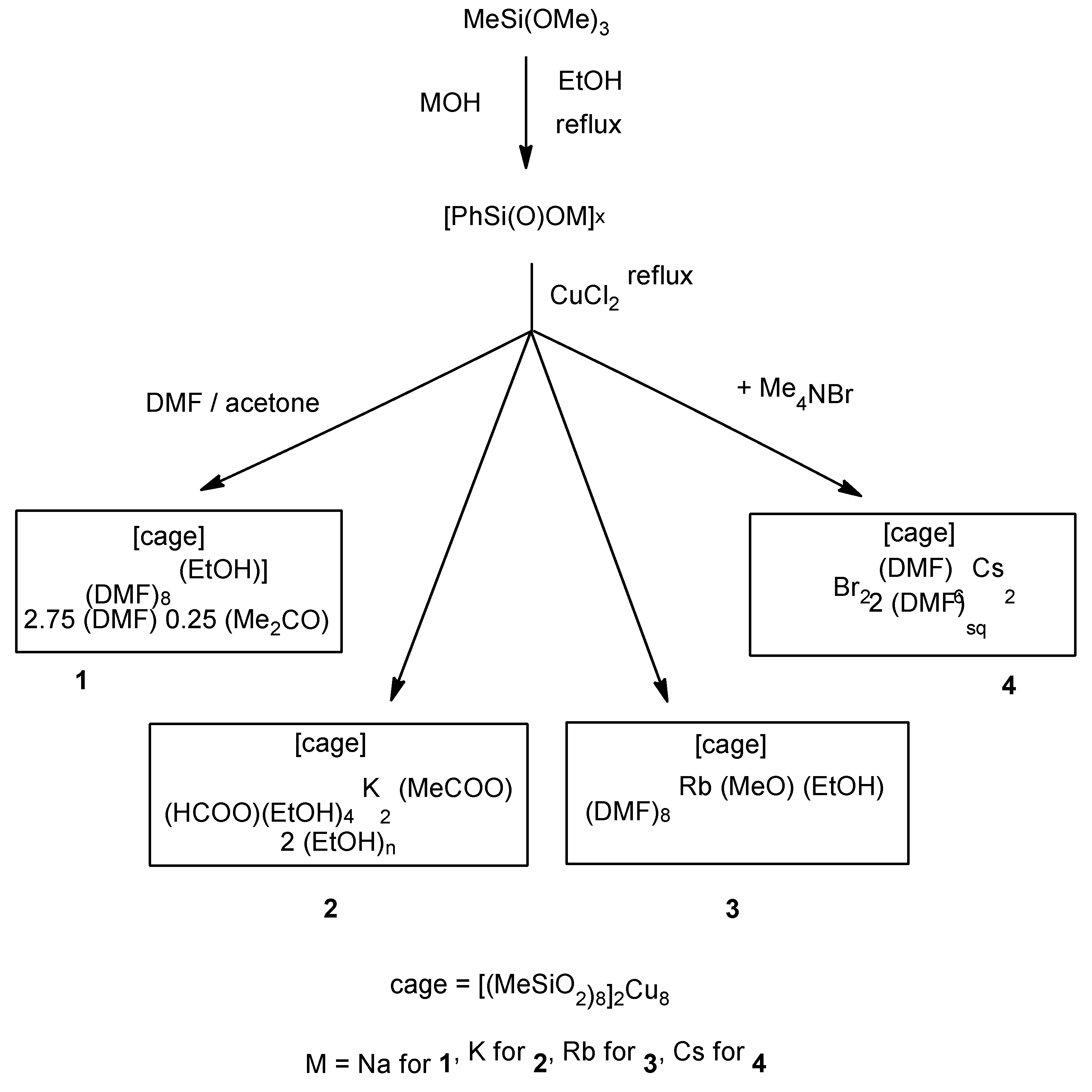
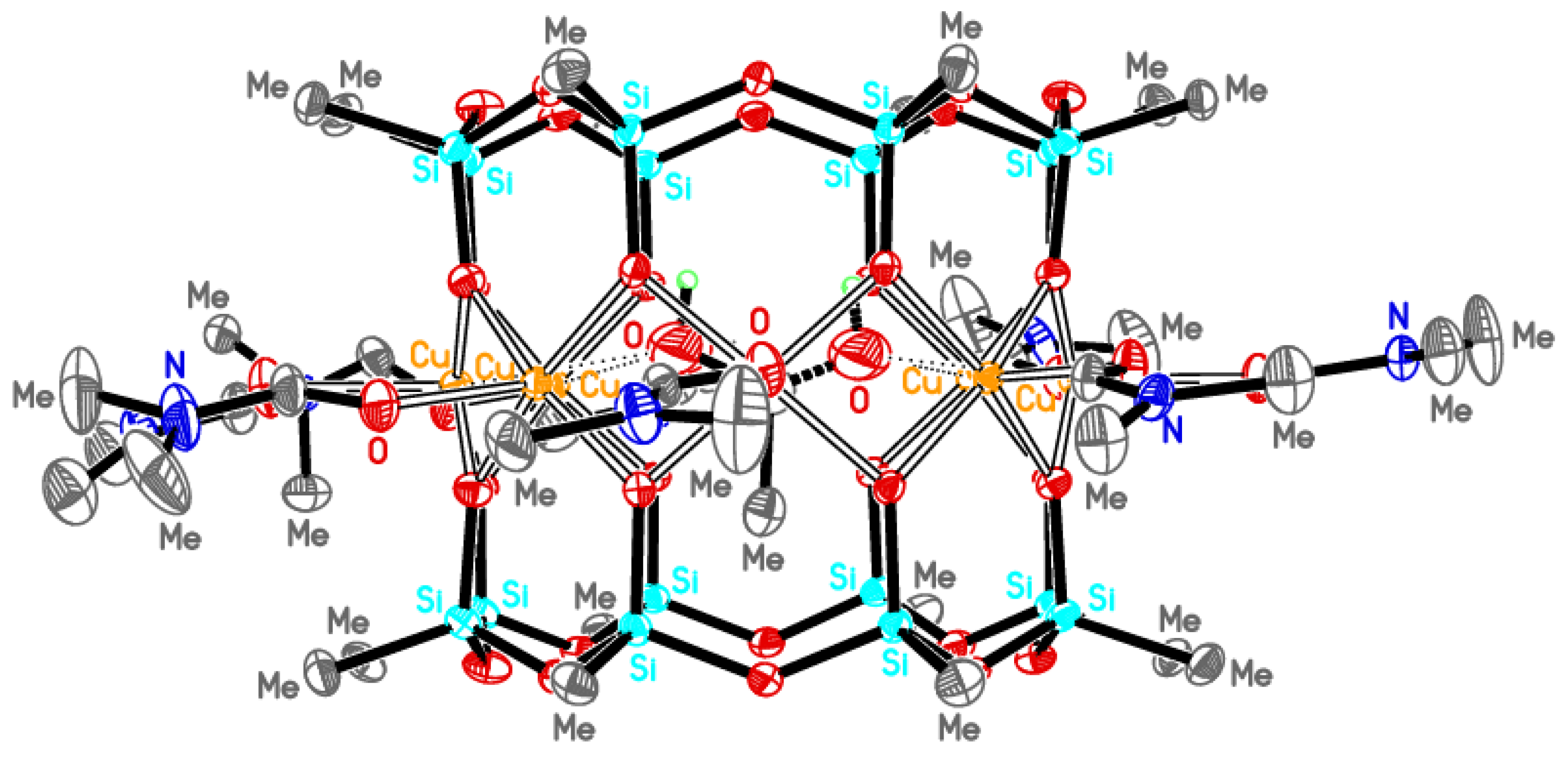

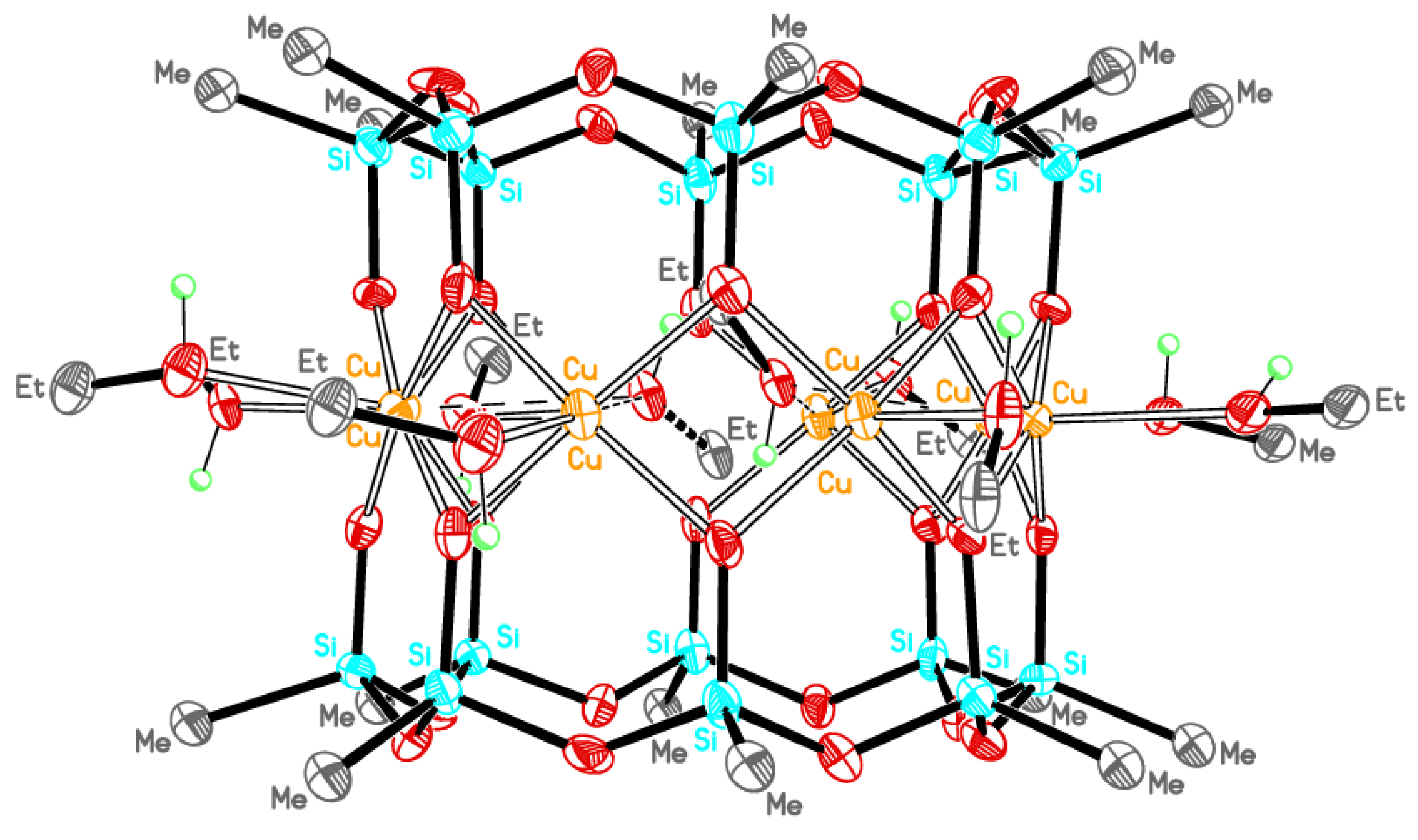
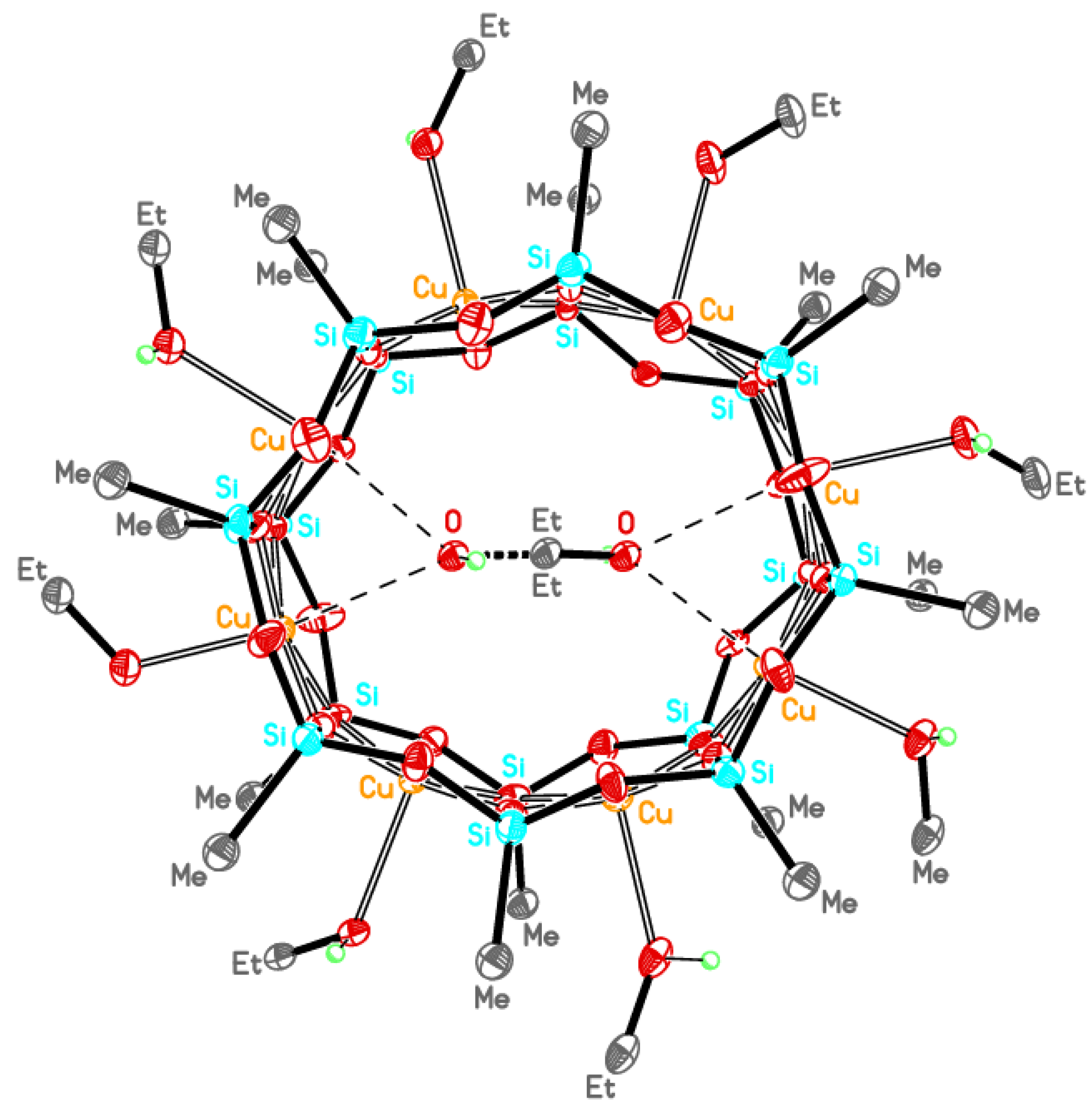



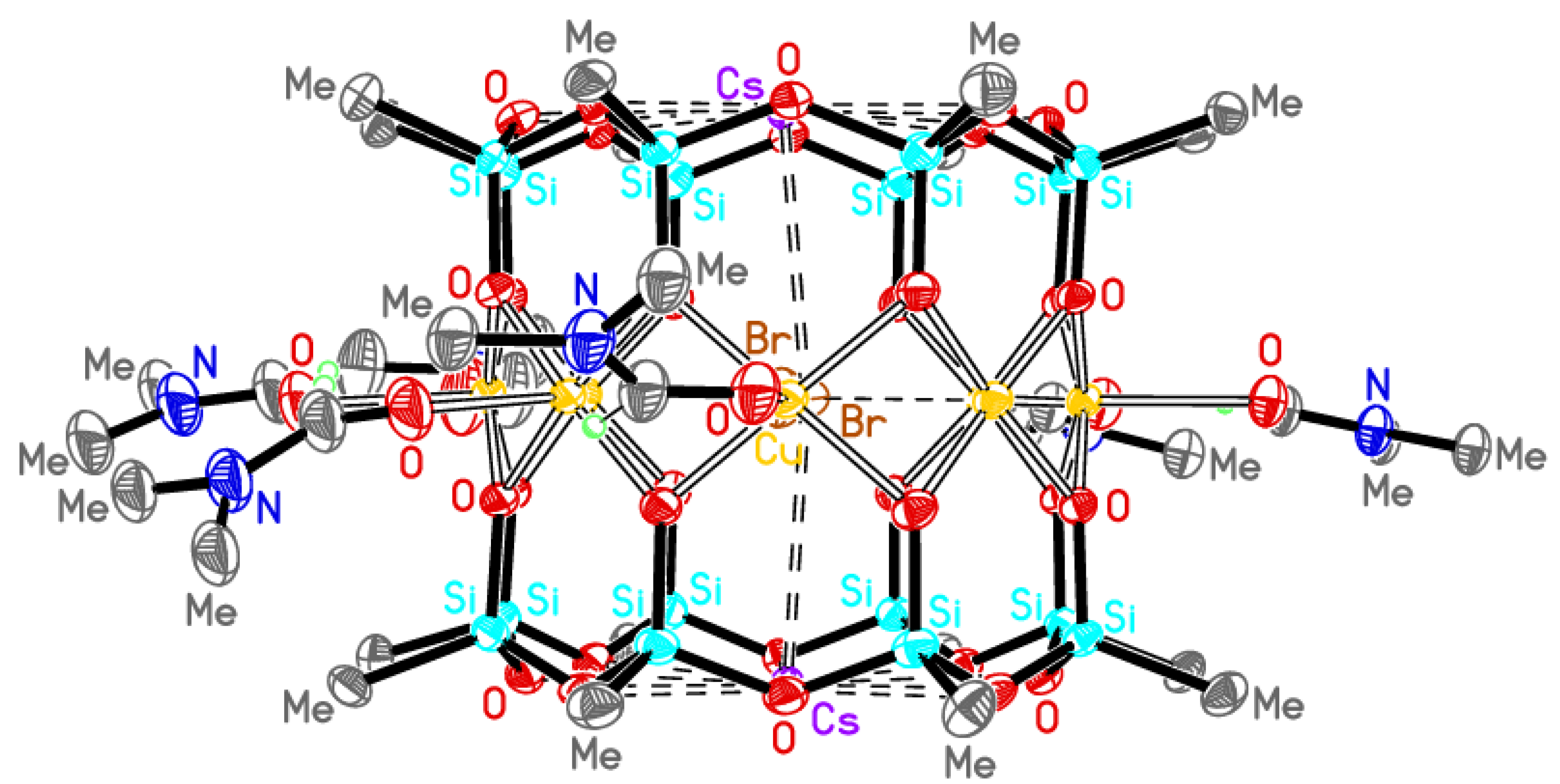
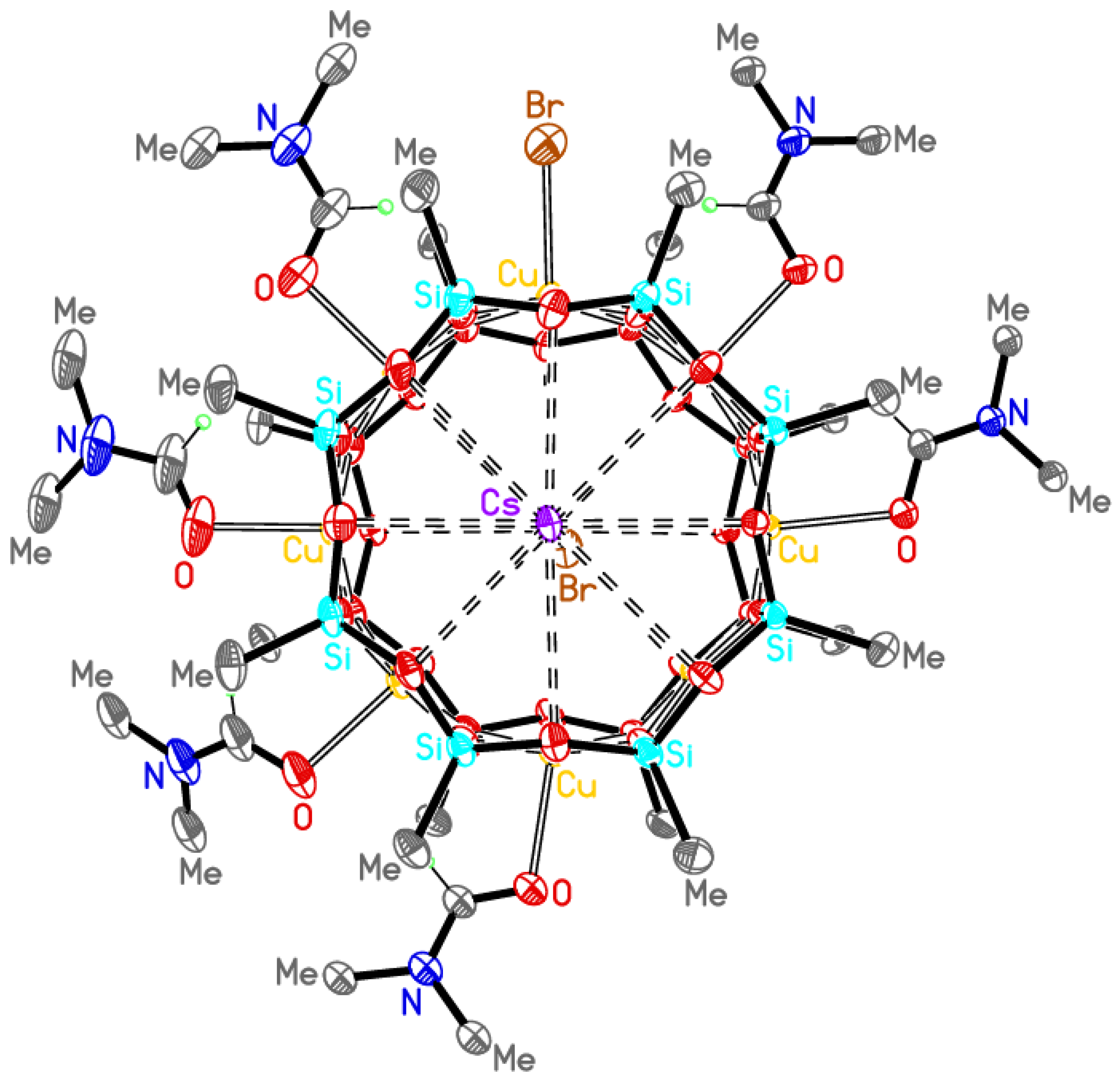
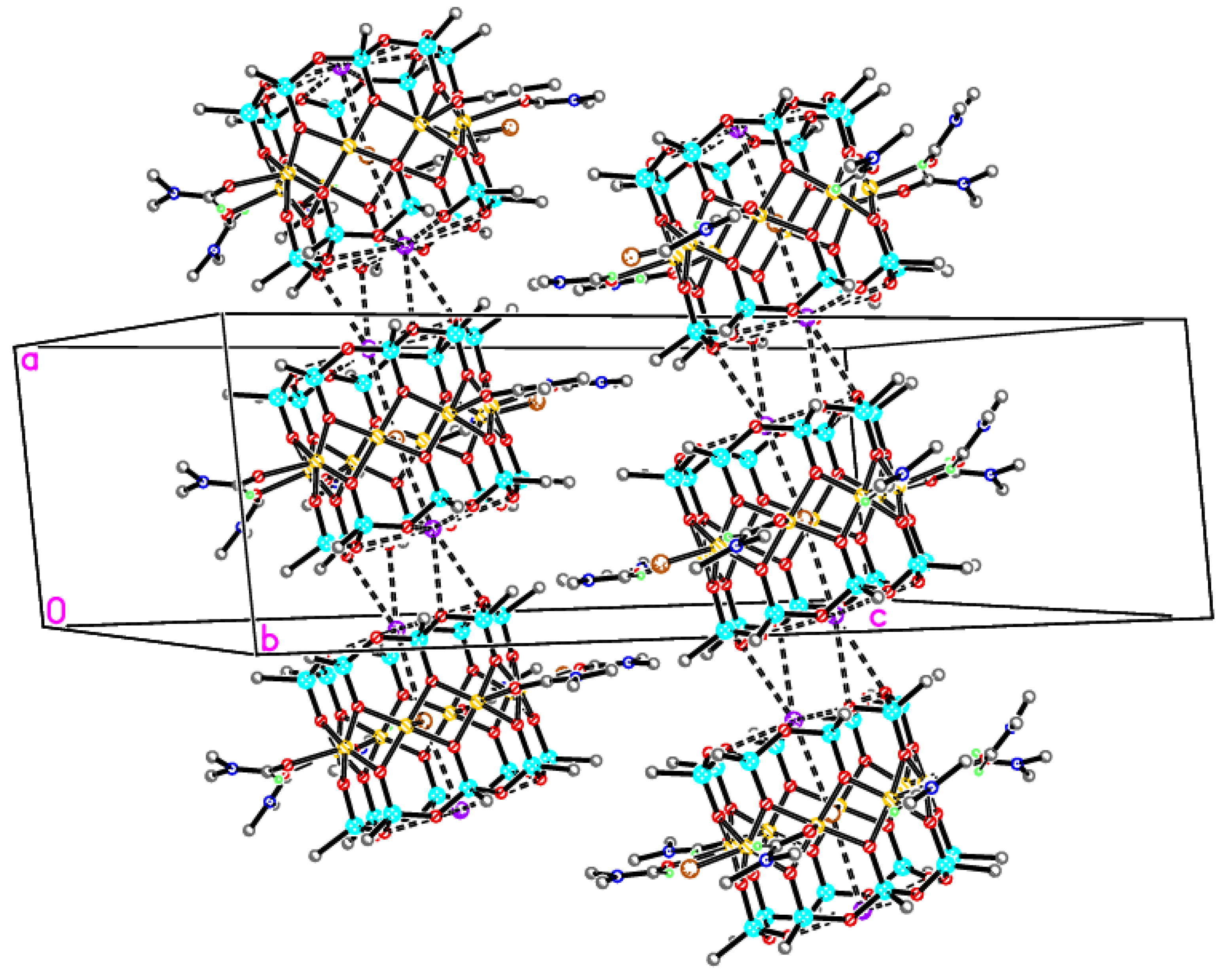
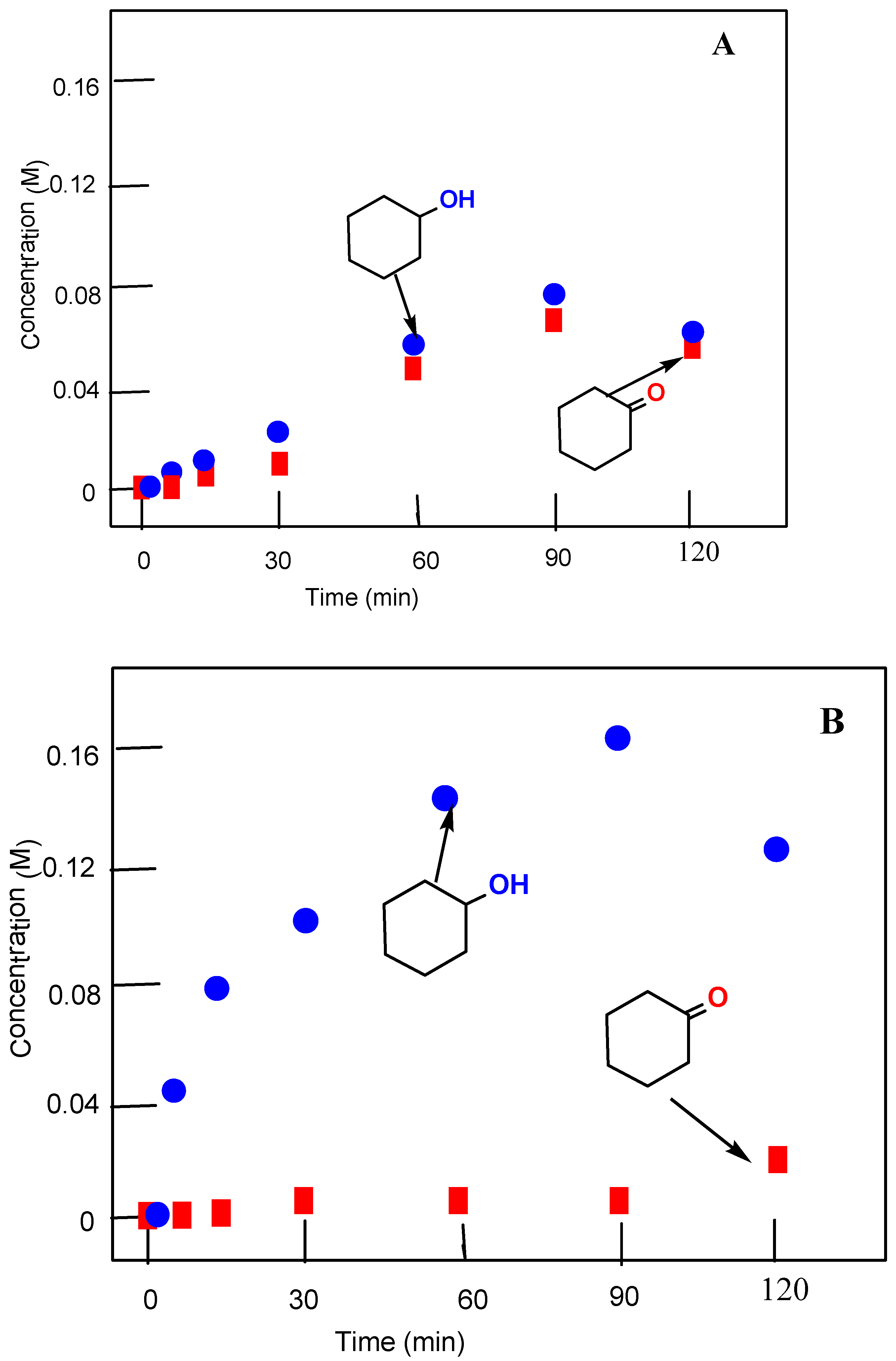
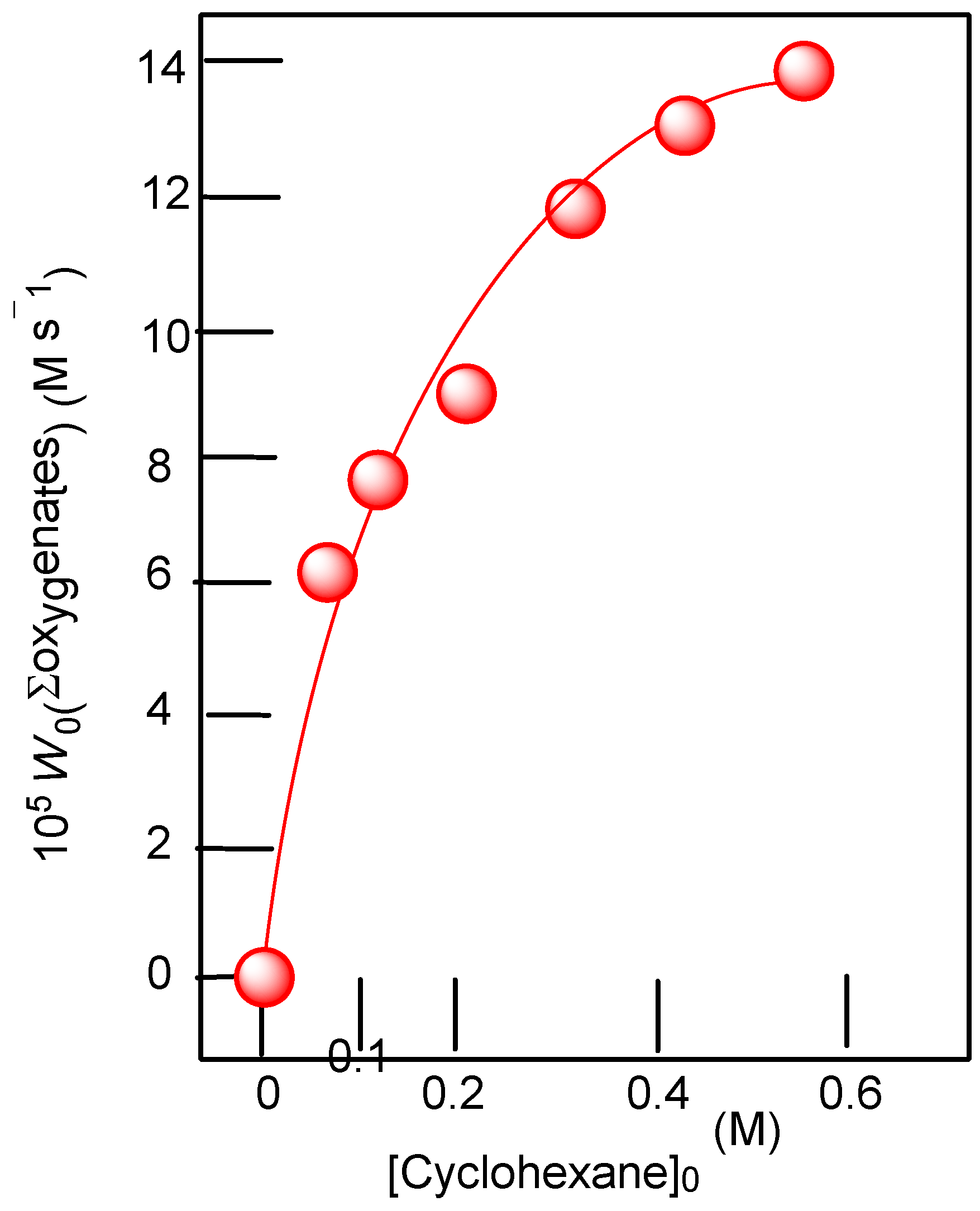
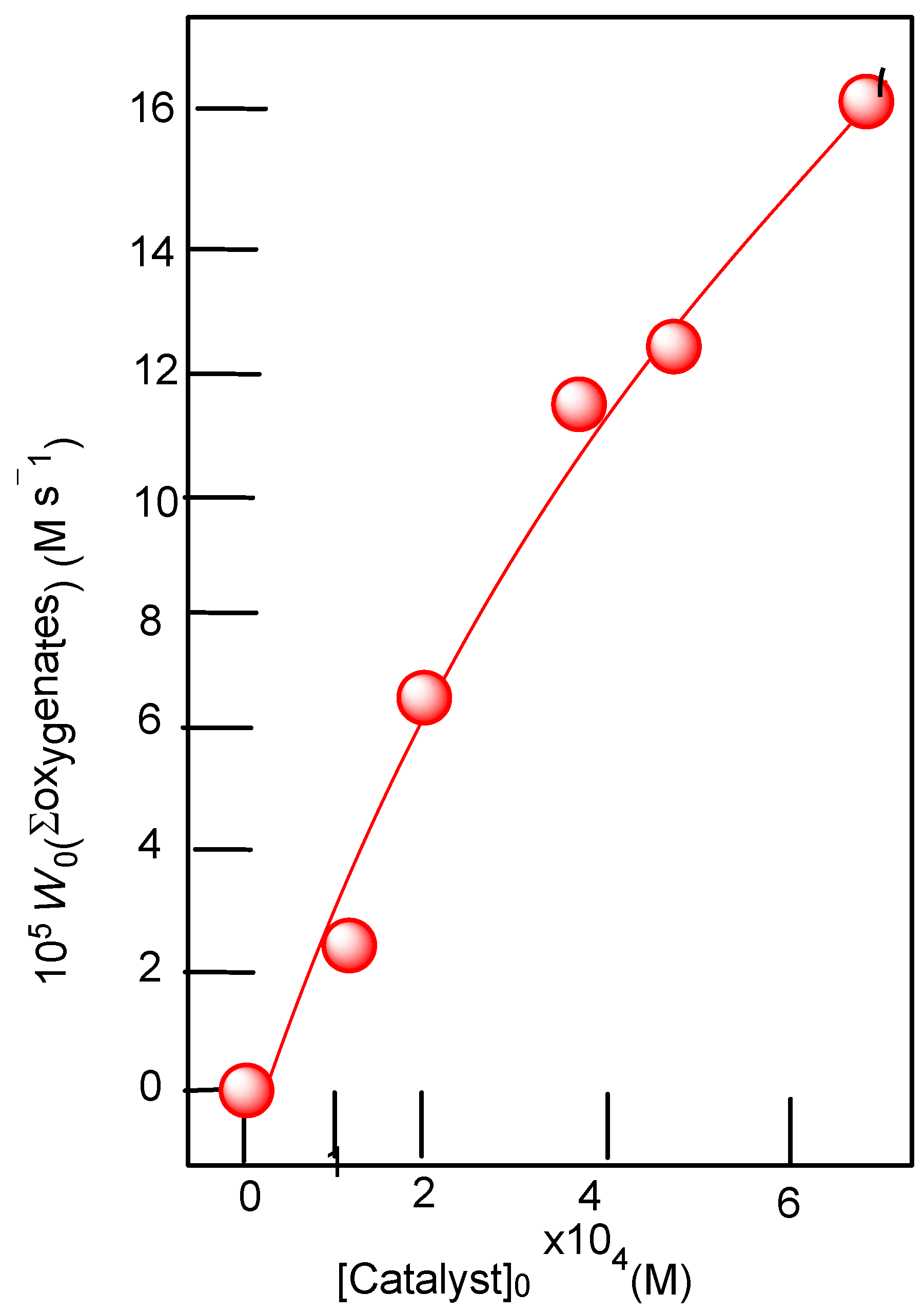
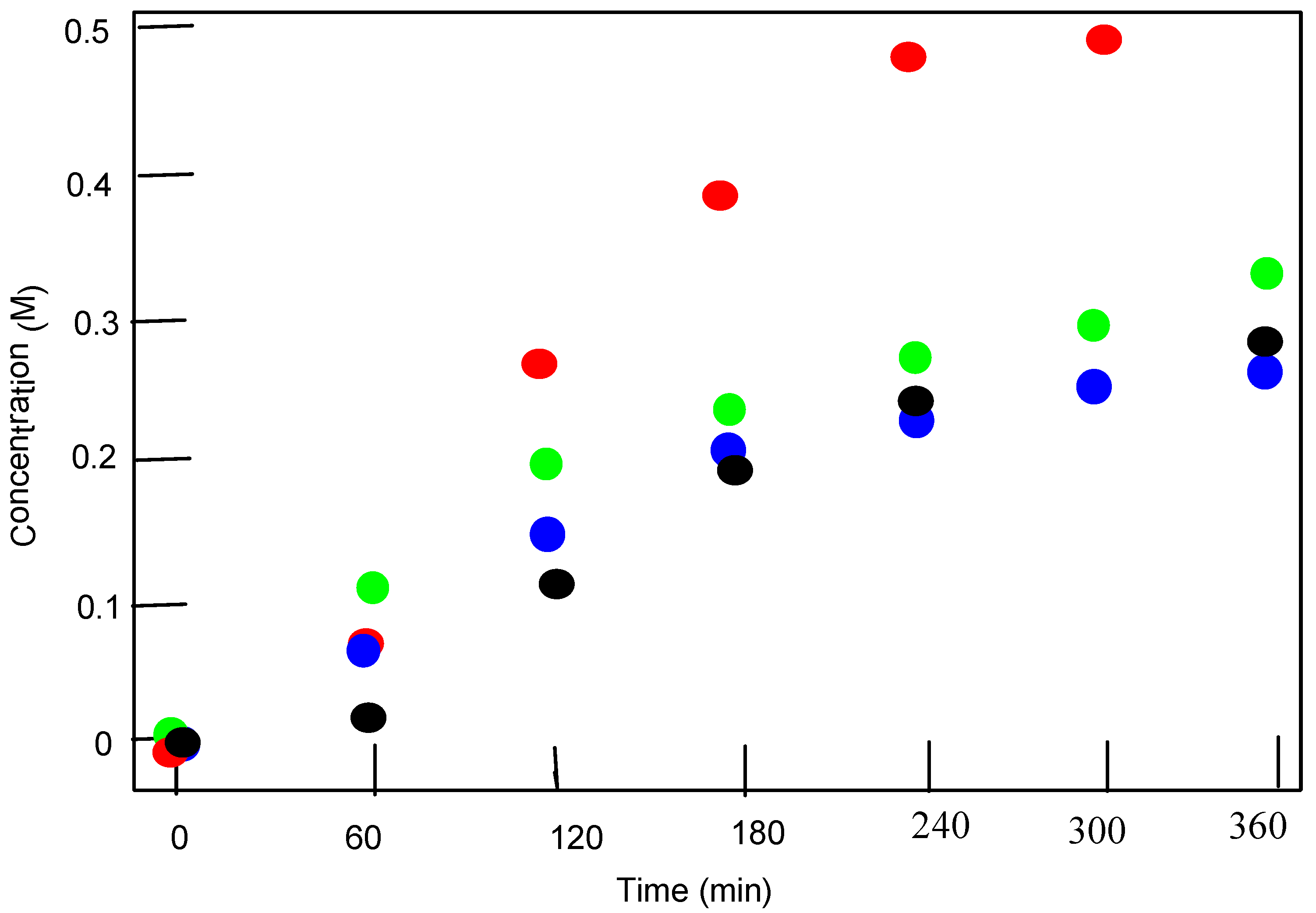
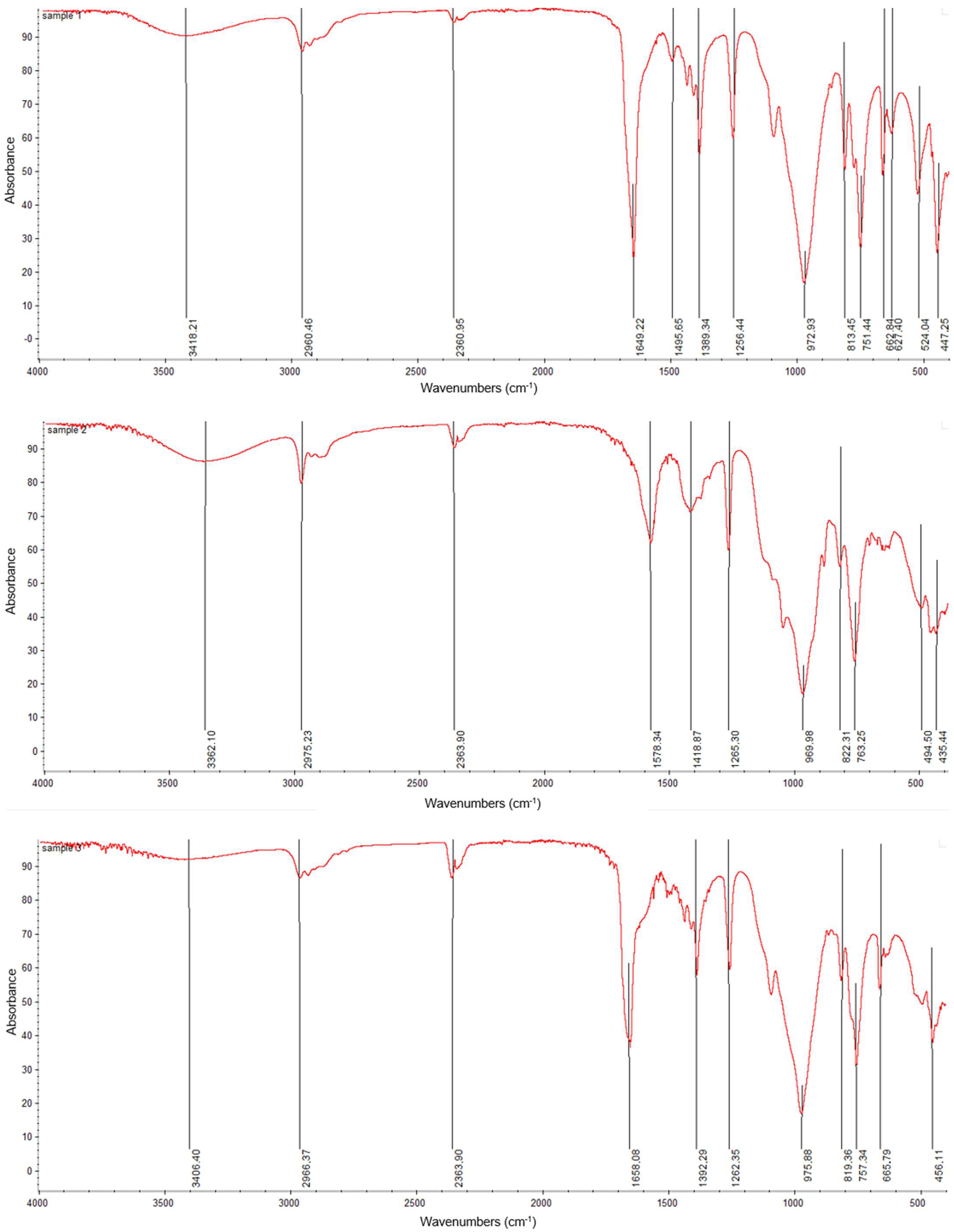


| Identification Code | 1 • 2¾C3H7NO • ¼C3H6O | 1a | 2 • 2C2H6O | 3 | 4 • 2C3H7NO |
|---|---|---|---|---|---|
| Empirical formula | C51H130.75Cu8N10.75O44Si16 | C129H388Cu32O161Si64 | C31H88Cu8K2O42Si16 | C43H113Cu8N8O42RbSi16 | C34H90Br2Cs2Cu8N6O38Si16 |
| Formula weight | 2556.76 | 8347.75 | 2169.06 | 2457.73 | 2574.58 |
| Temperature, K | 100(2) | 100(2) | 100(2) | 100(2) | 100(2) |
| Crystal size, mm | 0.20 × 0.18 × 0.15 | 0.12 × 0.06 × 0.03 | 0.23 × 0.13 × 0.12 | 0.15 × 0.13 × 0.12 | 0.35 × 0.05 × 0.03 |
| Wavelength, Å | 0.71073 | 0.75270 | 1.54184 | 1.54184 | 1.54184 |
| Crystal system | Monoclinic | Orthorhombic | Monoclinic | Monoclinic | Monoclinic |
| Space group | P21/c | P21212 | C2/c | P21/n | P21/c |
| a, Å | 18.7364(2) | 28.231(3) | 14.60230(14) | 17.15942(11) | 10.68626(9) |
| b, Å | 19.9150(3) | 16.8711(14) | 22.9138(2) | 14.19682(8) | 25.0419(2) |
| c, Å | 29.0275(3) | 17.3129(15) | 24.0571(2) | 21.78734(10) | 35.8364(3) |
| α, deg. | 90 | 90 | 90 | 90 | 90 |
| β deg. | 94.2936(11) | 90 | 98.2831(9) | 90.7073(5) | 95.0906(9) |
| γ, deg. | 90 | 90 | 90 | 90 | 90 |
| V, Å3 | 10,800.8(2) | 8245.9(12) | 7965.40(12) | 5307.19(5) | 9552.15(14) |
| Z | 4 | 1 | 4 | 2 | 4 |
| Density (calc.), g/cm3 | 1.572 | 1.681 | 1.809 | 1.538 | 1.790 |
| μ, mm−1 | 1.804 | 2.729 | 6.312 | 4.679 | 11.331 |
| F(000) | 5280 | 4274 | 4416 | 2512 | 5104 |
| Theta range, deg. | 1.996–35.458 | 1.992–30.992 | 3.713–77.656 | 3.716–79.599 | 3.741–78.402 |
| Index ranges | −28 ≤ h ≤ 29, −31 ≤ k ≤ 26, −44 ≤ l ≤ 46 | −38 ≤ h ≤ 38, −22 ≤ k ≤ 22, −23 ≤ l ≤ 23 | −18 ≤ h ≤ 18, −26 ≤ k ≤ 28, −30 ≤ l ≤ 30 | −21 ≤ h ≤ 21, −18 ≤ k ≤ 18, −21 ≤ l ≤ 27 | −13 ≤ h ≤ 13, −31 ≤ k ≤ 31, −45 ≤ l ≤ 45 |
| Reflections collected | 215,764 | 85,332 | 47,380 | 67,623 | 346,984 |
| Independent reflections | 44,011 (Rint = 0.0482) | 21,823 (Rint = 0.0701) | 8327 (Rint = 0.0436) | 11,268 (Rint = 0.0408) | 20,299 (Rint = 0.1134) |
| Reflections observed | 29,709 | 13,993 | 7365 | 10,617 | 18,431 |
| Restraints/parameters | 111/1170 | 71/756 | 15/462 | 67/496 | 0/840 |
| R1/wR2 (I > 2σ(I)) | 0.0510/0.1203 | 0.0721/0.1649 | 0.0556/0.1520 | 0.0715/0.1463 | 0.1054/0.2197 |
| R1/wR2 (all data) | 0.0927/0.1431 | 0.1124/0.1899 | 0.0610/0.1594 | 0.0740/0.1476 | 0.1116/0.2232 |
| Goodness-of-fit on F2 | 1.037 | 1.022 | 1.024 | 1.005 | 1.028 |
| Extinction coefficient | ─ | 0.00067(6) | ─ | 0.000250(16) | 0.000418(18) |
| Tmin/Tmax | 0.663/0.707 | 0.716/0.903 | 0.234/0.500 | 0.447/0.560 | 0.090/0.699 |
| Δρmax/Δρmin, e.Å−3 | 1.653/−1.363 | 2.043/−1.266 | 1.297/−0.814 | 2.604/−1.898 | 2.120/−2.670 |
Disclaimer/Publisher’s Note: The statements, opinions and data contained in all publications are solely those of the individual author(s) and contributor(s) and not of MDPI and/or the editor(s). MDPI and/or the editor(s) disclaim responsibility for any injury to people or property resulting from any ideas, methods, instructions or products referred to in the content. |
© 2023 by the authors. Licensee MDPI, Basel, Switzerland. This article is an open access article distributed under the terms and conditions of the Creative Commons Attribution (CC BY) license (https://creativecommons.org/licenses/by/4.0/).
Share and Cite
Bilyachenko, A.N.; Arteev, I.S.; Khrustalev, V.N.; Zueva, A.Y.; Shul’pina, L.S.; Shubina, E.S.; Ikonnikov, N.S.; Shul’pin, G.B. Cagelike Octacopper Methylsilsesquioxanes: Self-Assembly in the Focus of Alkaline Metal Ion Influence—Synthesis, Structure, and Catalytic Activity. Molecules 2023, 28, 1211. https://doi.org/10.3390/molecules28031211
Bilyachenko AN, Arteev IS, Khrustalev VN, Zueva AY, Shul’pina LS, Shubina ES, Ikonnikov NS, Shul’pin GB. Cagelike Octacopper Methylsilsesquioxanes: Self-Assembly in the Focus of Alkaline Metal Ion Influence—Synthesis, Structure, and Catalytic Activity. Molecules. 2023; 28(3):1211. https://doi.org/10.3390/molecules28031211
Chicago/Turabian StyleBilyachenko, Alexey N., Ivan S. Arteev, Victor N. Khrustalev, Anna Y. Zueva, Lidia S. Shul’pina, Elena S. Shubina, Nikolay S. Ikonnikov, and Georgiy B. Shul’pin. 2023. "Cagelike Octacopper Methylsilsesquioxanes: Self-Assembly in the Focus of Alkaline Metal Ion Influence—Synthesis, Structure, and Catalytic Activity" Molecules 28, no. 3: 1211. https://doi.org/10.3390/molecules28031211
APA StyleBilyachenko, A. N., Arteev, I. S., Khrustalev, V. N., Zueva, A. Y., Shul’pina, L. S., Shubina, E. S., Ikonnikov, N. S., & Shul’pin, G. B. (2023). Cagelike Octacopper Methylsilsesquioxanes: Self-Assembly in the Focus of Alkaline Metal Ion Influence—Synthesis, Structure, and Catalytic Activity. Molecules, 28(3), 1211. https://doi.org/10.3390/molecules28031211







